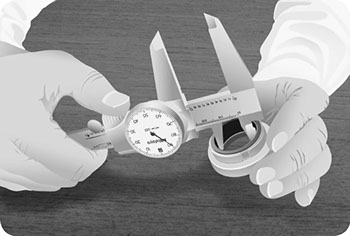Standard Seal Range
> Water Pump Seals
> Rubber Bellow Seals
> Diaphragm Seals
> Multi-Spring Seals
> Wave-Spring Seals
> External Seals
> Metal Bellow Seals
> Parallel Spring Seals
> Conical Spring Seals
> Stationaries
Seals by Brand
> Common Brands
> Other Brands
> ALBIN
> AQUAPLUS
> AUSSIE
> BIANCO
> CALPEDA
> CNP
> CORNELL
> CSF INOX
> DAB
> DAVEY
> DONJOY
> EBSRAY
> FLOMAX
> FORRERS
> FYBROC
> GAAM
> GODWIN
> GOULDS
> HAIGH
> HILGE
> HONDA
> INDENG
> JABSCO
> JAVELIN
> JEC
> MASOSINE
> NASH
> ONGA
> PIONEER
> REGENT
> ROBUSCHI
> SAER
> SEEPEX
> SELWOOD
> SHERWOOD
> SIHI
> SPECK
> STALKER
> STANDART
> SYKES
> TSURUMI
> VARISCO
> VIKING
> WANGEN
> WAUKESHA
> ZENIT
Seals by Type
> Pump Type
Seal Refurbishment Services
Elastomer Chemical Compatibility
Seal Face Chemical Compatibility
SEAL IDENTIFICATION
The process below demonstrates the correct procedure of measuring and properly identifying a mechanical seal in 3 easy steps:
STEP 1: IDENTIFYING SEAL TYPE & ARRANGEMENT
A mechanical seal can be identified, often visually, by looking our for how it's mounted to the shaft:
RUBBER BELLOWS MOUNTED
- Diaphragm Seals
O-RING MOUNTED
- Parallel Spring
- Conical Spring
- Multi Spring
- Wave Spring
- Metal Bellows
- PTFE Bellows
A mechanical seal can also be identified by arrangement:
DOUBLE SEAL
- Back-to-back
- Face-to-Face
- Tandem
SINGLE SEAL
- Internally Mounted
- Externally Mounted
STEP 2: IDENTIFYING SEAL SIZE & MATERIAL
In determining the size of your mechanical seal, use a precision measuring tool, ideally a set of vernier calipers to measure the following:

MEASURING & DETERMINING SHAFT SIZE
The shaft size, often denoted as 'D1', can be measured either:
1. Directly on the shaft where the seal is mounted or;
2. The inside diameter (ID) of your mechanical seal where for:
a) Rubber bellow mounted seals is the ID of rubber bellow
b) O-ring mounted seals is the ID of the O-ring
IDENTIFY THE SEAL FACE MATERIALS
Common seal face materials can be identified visually:
Carbon (CAB):
Ceramic (CER):
Silicon Carbide (SiC):
Stainless Steel (S.S):
Tungsten Carbide (TC):
Black in colour, rough to touch
White in colour, smooth to touch
Blue-grey in colour, smooth to touch
Metallic, smooth to touch
Similar to S.S, heavier, smooth to touch

MEASURING STATIONARY TYPE, CAVITY & HEIGHT
Determine the style of your stationary, the two most common being
cup mounted or o-ring mounted.
To measure cup mounted stationaries:
1. Measure the outside diamater (O.D.) of the rubber cup (D7)
2. Measure the height (L4) from the rubber cup to the seal face
To measure o-ring mounted stationaries:
1. Measure the OD of the o-ring
2. Measure the height where for:
a) o-rings located in the middle, from the back face to front face
b) o-rings located in the back, from the back face to the o-ring
STEP 3: IDENTIFYING SEAL BY PUMP DESIGNATION
Often your pump type, manufacturer or model number can be used to determine whether the mechanical seal is standard or pump-specific:
DETERMINE THE PUMP TYPE & MANUFACTURER
Determine what type of pump, i.e. centrifugal, submersible, lobe, gear, agitator or compressor
Determine what pump brand, i.e. Grundfos, Ajax, Alfa Laval, APV, Ebara, Flygt, Inoxpa & Southern Cross etc.
IDENTIFYING THE PUMP MODEL & SIZE
Each pump manufacturer has their own designation or type key for their respective pump ranges.
We can normally determine the seal if you send a photo of the pump's nameplate


